In this article, we’ll cover a range of low-maintenance fish species that are perfect for beginners. W also discusses the care requirements, behavior, and compatibility of these fish to help beginners make an informed decision.
When selecting fish for a beginner aquarist, one of the key factors is finding low-maintenance species. Like any hobbyist starting, you will want to make sure you do not inundate yourself with too many responsibilities too early.
Table of Contents
15 Recommended Low Maintenance Fish
One way to minimize headaches is to make choices that involve low maintenance features and what better place to make a low maintenance choice than the fish themselves?
Listed below are some of the most low-maintenance fish that are sure to be solid choices for your beginner aquarium.
Bettas
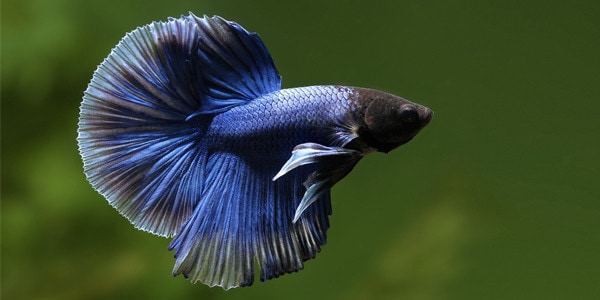
One of the lowest maintenance fish is the venerable Betta.
Not only are they low maintenance, but they also exhibit brilliantly bright colors in a variety of shades. The males are especially known for having long, luxurious fins.
Due to their lavish fins, you may want to be careful about mixing other species of fish with the Betta since they may come under attack.
Colloquially known as “Siamese Fighting Fish,” they are known to have violent interactions with other fish of the same species so definitely keep the headcount on this variety to one! Relatively speaking, they are a rather sturdy breed and can eat both flake food or fish food pellets.
- LIVE BETTA FISH: You will receive 1 male pure blue halfmoon betta fish.
- Size | Approx 1-2" Length
Platies
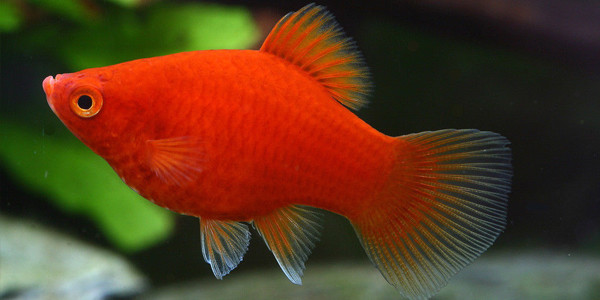
When it comes to mixing and matching fish, Platies are a good choice. They come in a good variety of colors and are bred specifically to create new and different color combinations. There are enough varieties to satisfy almost anyone’s taste.
They are also known for getting along well with other passive fish species. Since they are a live-bearing species, they will produce offspring at a high rate, but be careful, as some other species might view their offspring as a food source.
On the topic of food, Platies will eat most varieties of food including freeze-dried fish food or dry flakes. Not only will they eat most types of prepared fish food, but they are also known to eat algae in the fish tank, posing as a cleaning crew for the ecosystem.
Black Molly
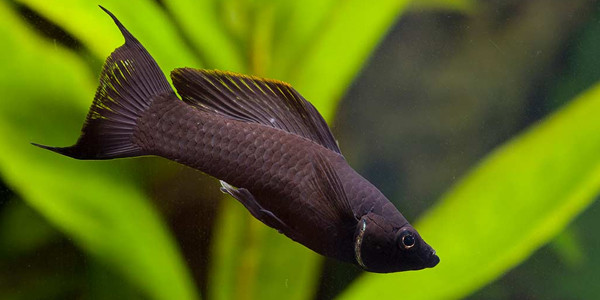
If you want a more community-oriented fish, then look no further than the Black Molly. A passive fish, the Black Molly is well suited to life in a diverse aquatic environment. Not only are they good with other fish species, but also they are well suited to varied water types.
They can adapt to salt water, fresh water, or even brackish water, which makes them a good choice for almost any tank. Similar to the Platies, the Black Molly species are livebearers; only, in this case, the parents will eat their offspring if there is not ample vegetation in which the young fish can hide.
Swordtail
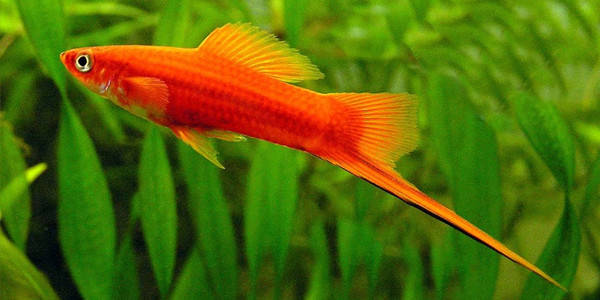
A close relative of the Platies, the Swordtail look much tougher than they are. A long fin along their ventral side resembles a sword, hence their name. Despite their aggressively styled name, Swordtails are quite passive and also come in a range of colors. These fish have relatively long life spans making them a big hit with beginners.
No products found.
Goldfish
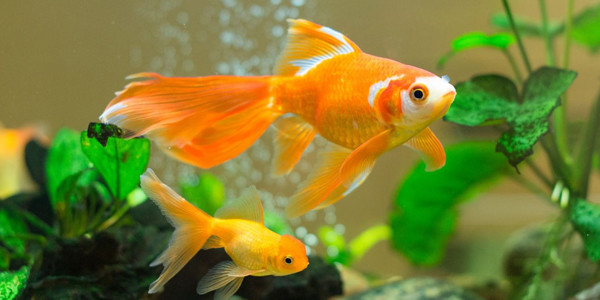
Last, but not least, is everyone’s original favorite pet, the Goldfish. Whether you choose Goldfish for their wide spectrum of colors, the range of sizes, or the fancy varieties with bubbleheads and big eyes, they are great for beginners.
Goldfish do prefer water on the colder side (specifically 60-70 degrees Fahrenheit) so make sure to keep them in a room temperature tank. In regards to food, Goldfish tend to make a mess, meaning their water will require a little bit more cleaning than some of the other fish on this list.
- Shubunkin Variety: Enrich your aquatic realm with Toledo Goldfish Shubunkin Goldfish, distinguished members of...
- Striking Aesthetics: Each Shubunkin Goldfish boasts a unique appearance, with no two sharing the same pattern....
Zebra Danio
When you go to an aquarium store to bring home a pet fish, goldfish is the most common choice. However, Zebra Danio is a close second. Ideal for cold water aquariums, the striped appearance of this fish stands out in the tank.
Some have the staple white body with black stripes along the length while a few others have a yellow hue to their scales. The fish is quite small and only grows 2-3 inches. The best reason why they are beginner-friendly is thanks to their adaptability. They are hardy and very easy to breed.
They are native to South Asia and need a well-oxygenated aquarium for optimal growth. Also, when it comes to water parameters, be mindful of the temperature. Anything above 75 degrees Fahrenheit will put them under stress. The feeding cycle is easy and they will more or less gobble down anything you feed them.
| Scientific Name | Danio rerio |
| Origin | South Asia |
| Size | 1-3 inches |
| Temperament | Peaceful |
Dwarf Otocinclus
When you have a community tank, maintaining diversity is key. You want to include surface feeders and bottom dwellers. But, adding an algae eater is important too. Dwarf Otocinclus takes care of that. They are a small fish species that keep your tank clean and move in schools.
Besides gobbling down algae, they also take care of the aquarium plants. They are vegetarians, so live feeds won’t do them good. However, when taking care of them, make sure you feed them extra veggies since they can’t live off of algae only.
The water parameters are pretty staple. They need around 5-7 pH with water temperatures between 75-84 degrees Fahrenheit.
| Scientific Name | Otocinclus vittatus |
| Origin | Amazon River Basin |
| Size | 1-2 inches |
| Temperament | Peaceful |
White Cloud Minnow
Push aside platies and guppies; minnows are an underrated but equally intriguing fish species. They are cheap and perfect for beginners who want to start with simple and small fish in the tank.
The iridescent appearance shines under the aquarium light, making it a treat to the eyes. Also, the stripe runs down the length of the body and is used as a defense mechanism. They are quite active in the tank and very fascinating to look at.
The only issue with this species is that they need cold water to survive. So, when putting them in a community tank, you need to find tank mates accordingly. They can live in colder water as low as 41 degrees Fahrenheit.
For their feeding, they rely on live and frozen foods. So, make sure you treat them accordingly. Low water hardness is also important to check.
| Scientific Name | Tanichthys albonubes |
| Origin | Southern China |
| Size | 1-2 inches |
| Temperament | Peaceful |
Ramshorn Snail
Why do you have to stick to just fish species? Adding a Ramshorn snail can be a fun option too. They are very peaceful and often like to keep to themselves. However, they are interactive, so you can talk to them from outside the tank.
The breeding cycle of this snail is very rapid. So, if you are keeping them in a community tank, be aware of that. They are hermaphrodites, so they don’t need mates to produce more. The benefit to them is that they clean up after the other fish species.
From leftover food to dead plants, they will clean everything up. This reduces your burden of cleaning the tank every few weeks. They stand out in the tank due to their bright and vivid colors too.
| Scientific Name | Planorbidae |
| Origin | Florida |
| Size | 1 inch |
| Temperament | Peaceful |
Dwarf Gourami
Gouramis are popular additions to aquarium tanks. They are small, easy to maintain, and don’t indulge in signs of aggression. What’s not to like, right? They are also ideal for community tanks, which is always a benefit.
They have a labyrinth organ and come up to the surface for more air. The males are smaller yet more vibrant than the female ones. The breeding process is simple with this species if you were worried about the same.
As for water parameters, you need warmer water temperatures between 76-84 degrees Fahrenheit. Also, the pH needs to be slightly acidic to neutral. They don’t rely on plants or vegetables and need a protein-rich diet. So, feed them accordingly.
| Scientific Name | Trichogaster lalius |
| Origin | South Asia |
| Size | 2.5 to 3 inches |
| Temperament | Peaceful |
Neon Tetra
As a beginner, budget is the first thing everyone looks out for. So, it isn’t even a question that neon tetras make the cut. They are affordable, versatile, and very easy to maintain. Their origin dates back to 100s of years back and is readily accessible globally.
Like most tetras, they need warmer water temperatures with a slightly acid water pH. They are very hardy and easy to breed as well. Since they are native to the Amazon River Basin, it isn’t surprising that they need round-the-clock tropical water conditions.
More than vegetables, they rely on prey and live foods. So, adding brine shrimp, daphnia, etc., work well for their feeding. They are schooling fish, so never buy them alone. A minimum of 6 needs to be kept in the tank.
| Scientific Name | Paracheirodon innesi |
| Origin | Amazon river basin |
| Size | 1-2 inches |
| Temperament | Peaceful |
Cherry Barb
Cherry barbs are pretty great if you want to add a pop of color to the tank. Don’t get confused with their cousins. They aren’t aggressive or territorial at all. They like to stay in the tank for a comfortable swim and relaxation.
They are very interactive and like to zoom across the tank from one end to the other. They are native to Sri Lanka and are predominantly found in heavy flowing streams. Also, they are schooling fish, so you need to keep them in groups of 6-8.
The appearance of the fish is what makes it so unique. The bright ruby red with orange shades on the body stands out in the tank. They are very easy to breed, and the males take care of the eggs till they hatch.
| Scientific Name | Puntius titteya |
| Origin | Sri Lanka |
| Size | 1-2 inches |
| Temperament | Peaceful |
Black Skirt Tetra
While neon tetras are very old-school and common, Black Skirt Tetra is an exotic addition to the tank. They are perfect for community tanks, especially if you want a low-maintenance tank.
The mild and dark coloration of this species gives it a muted look. However, the flared fin in the back appears like a skirt and adds an attractive trait to it. They are comparably larger than most tetras. Also, they are carnivores. So, if you are trying to feed them vegetables, chances are they will not eat them.
This is also one of the fish species placed under the glofish variant. They are easily available and very hardy.
| Scientific Name | Gymnocorymbus ternetzi |
| Origin | Brazil |
| Size | 2-3 inches |
| Temperament | Peaceful |
Kuhli Loaches
Every tank needs a bottom dweller, and Kuhli loaches are the perfect choice for that. They are one of the most active species and like to feed multiple times a day. Also, they are very social with their surroundings and their tankmates. So, if you find them nudging or following other species, they just want to interact.
Besides their dynamic behavior, their appearance is pretty unique too. Despite their small size, they have vibrant colors with black spots and patches all over the body. They do well in fine grain and sandy substrates. Always avoid rocks and gravels with loaches since then burrow into the substrate.
When it comes to feeding, they need a balanced and protein-rich diet. Live feedings are ideal, especially if it involves invertebrates like shrimps.
| Scientific Name | Pangio kuhlii |
| Origin | Malaysia, Indonesia |
| Size | 4 inches |
| Temperament | Peaceful |
Celestial Pearl Danios
Although a little expensive compared to other beginner-friendly fish species, the pearl danios change the look of your tank. Despite the small size, the blend of blue, orange, and white spots stands out amidst all the other fish.
They are an exotic species, so finding them in the tank can be confusing. While housing the, make sure you maintain the pH neutral in the tank. Any drastic change to the water will end up putting them under stress.
You won’t necessarily find them schooling, but they still like to stay in groups for safety. They also need hiding spots, so adding plants and decorations is necessary. Also, when choosing their tankmates, make sure you avoid pairing them with big species since they will feel threatened in such environments.
| Scientific Name | Danio margaritatus |
| Origin | Myanmar |
| Size | 1 inch |
| Temperament | Peaceful |
FAQs
What is a low-maintenance fish?
Low-maintenance fish are the ones that require less attention and care. They are hardy, well adaptable, and live to keep to themselves in the tank. They are also great tankmates and interactive during the feeding.
Are Bettas easy to maintain?
Yes, bettas are very easy to maintain, provided you know how to take care of them. If you maintain the right water parameters, do well with the feeding, and keep the tank clean, bettas will adapt themselves accordingly.
What are some best tanks or aquariums for low-maintenance fishes?
If we had to suggest top tanks or aquariums for low-maintenance fishes like bettas and tetras, the biOrb Classic 60 Aquarium and Hygger Horizon 8 Gallon LED Glass Aquarium are pretty great choices.
What are some of the best freshwater aquarium fish combinations?
A combination of guppies, platies, and tetras work very well in a freshwater aquarium. They are good tankmates, compatible, and very peaceful too.
What are the best tropical fish for beginners?
Guppy, cory catfish, and neon tetras are ideal tropical fishes for beginners. They are easy to care for and adapt well to their surroundings.
Choose Wisely
Any of the species listed here would be great for beginners, but each one has its pros and cons. At the end of the day, the most important thing is to pay attention to your aquarium and your fish. If something is wrong (or right!) your fish will let you know with their behavior. Give them everything they need to thrive and they will provide you with years of entertainment.
No related posts.



9 thoughts on “Low Maintenance Fish for Beginners”
Hi I think you should add pictures of the fish to this site, just so people can know what their options look like. Thank you!!!
Thanks for the suggestion, Gabi. Will look into that. =)
Of the fish listed how many of each or how would you make a nice calm colony of them in a 20 gal. tank. Thanks! I just set up the aquarium and it’s heated, but never had fish before.
I’m just looking for a nice calm colony of fish.
Hi Lorri,
It all depend on your preference and how you setup your tank. The only concern would be overcrowding. Here’s where I would direct you to AqAdvisor where you can input the type and quantity of fish and the site will tell you if it is ok or not. Try it! =)
My tank says it’s a 15 gallon tank. But once filled it only holds approximately 10-12 gallons. Should I treat it as a 10 gallon tank?
This is an alright list, but goldfish are not a good beginner fish. They require very high levels of filtration and a much larger tank than most are willing/able to give them. Any fancy goldfish will need a 30 gallon tank, minimum for a single fish with a 300gph filter. Comet goldfish have no place in a fishtank and should be kept in large pond that allow the the space they require. If it’s the color that attracts you to them, then mollies, platies and swordtails would be a much better option for a home aquarium.
NO guppies?
When I was a kid,60yrs ago I remember we had a aquarium with guppies. Seems as I remember they have lots of babies which would get eaten by their parents. We had to separated them so the parents would be be putin a small holder hung on side of tanks.
I am getting ideas on setting up a 25 gallon aquarium. Would guppies work with Mollies, platies and Swordtails?
Any comments,opinions help would be much appreciated. Thanks
I agree, why no guppies mentioned?! And I’ve found mollies to be bullies. So what else goes with fancy guppies? I don’t care if they eat some of the guppy babies — that’s what fish do. My large Glowfish Tetras all died except one. I’m trying 6 fancy guppies (2 female) and three small ZebraDanios. Any advice?